#Newlyn School
Text

ChatGPT with DALL-E
An impressionistic painting in the style of the Newlyn School, featuring three bodybuilders of diverse descents - one Caucasian, one Black, and one Hispanic. They are depicted swimming and relaxing on sunlit rocks beside a serene sea. The painting captures the harmonious blend of human forms and the natural beauty of the seaside, with a focus on peaceful ambiance. The brushwork is loose and expressive, typical of impressionism, with vibrant colors and dynamic light effects that convey the mood of a tranquil, sunny day by the sea.
30 notes
·
View notes
Text
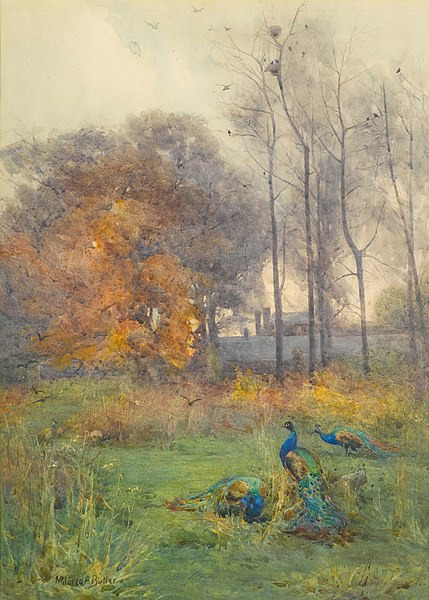
Mildred Anne Butler (1858-1941)
"Autumn Days" (1928)
#paintings#art#artwork#landscape painting#peacock#mildred anne butler#fine art#irish aritst#woman artist#women artists#female artists#peacocks#birds#animals#trees#1920s#early 1900s#early 20th century#newlyn school
244 notes
·
View notes
Photo
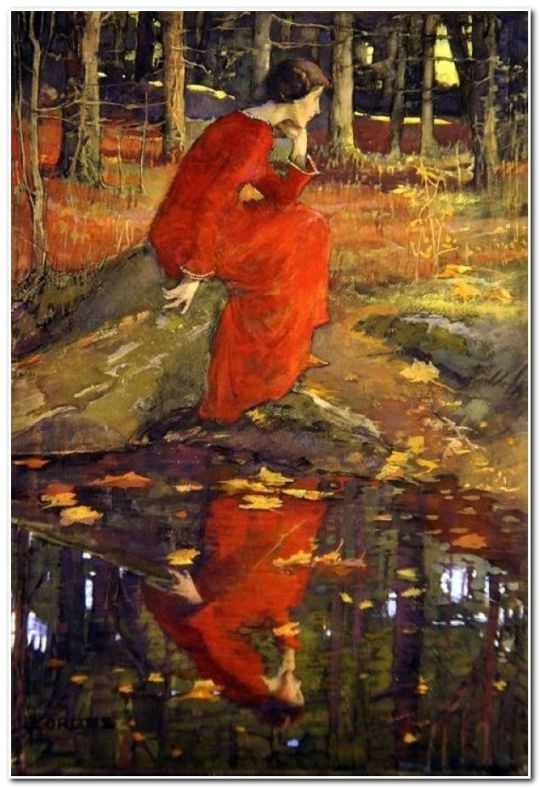
Elizabeth Forbes
The leaf (1897)
21 notes
·
View notes
Text
Maritime Art. Part 2.
The Sea and the Workers who risk their lives for others.
In this look at Maritime or Marine Art I want to showcase those paintings which feature the people who have dedicated their lives to saving seafarers and those working the seas in a continual search for food to put on our tables.
For the first of my forays into the depiction of fisherman I want to delve into the work of the great Skagen…

View On WordPress
#Art#Art Blog#Art History#Aviazovsky#J.M.W. Turner#Marine Art#Marine paintings#Michael Ancher#Newlyn School#Peder Severin Krøyer#Rembrandt#Skagen painters#Walter Langley#William Falconer
0 notes
Photo
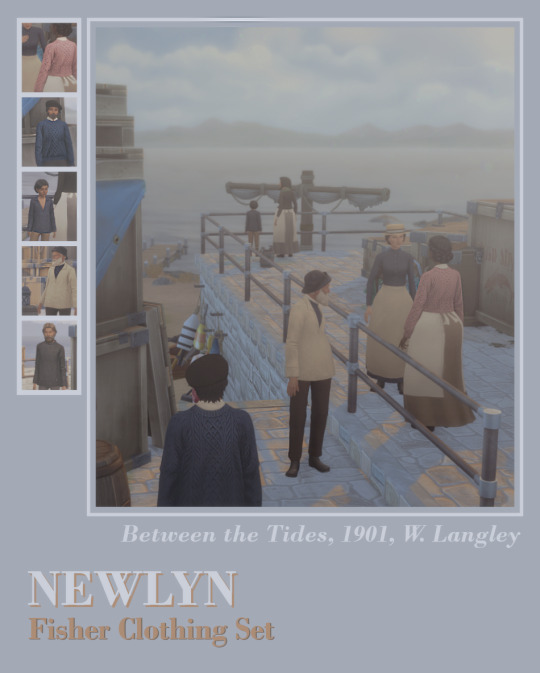
Newlyn Fisher Clothing Set
I come to you today with this little historical seaside fashion interlude (before going back to work on more 1880′s sets). This set includes cable knit sweaters in high and low waisted, and variations on traditional fishermen smocks.
More pics and download below
This set is partly inspired by the works of the school of Newlyn, a group of painters known to have depicted the surrounding of Newlyn, a Cornish coastal town, and its many fishermen in the 1880′s to 1900′s.
And here is the painting that I referenced in the promo picture.
————————— Cableknit Sweater ————————

———————————————————————————
This is the sweater from the Werewolf pack without the little laced up strings on the shoulders (why do you always add these unnecessary details EA ? 😅). I’ve made a short version (S) for my high waisted needs and a long (L) version, for both masc and fem frames, as well as both adult and children.
Cableknit sweaters originated from Ireland, in the Aran Islands, though other types of knitted jumpers called gansey already existed in the British, Irish and Channel isles. They were created between the 1890′s and 1900′s. They were initially knitted with unwashed and undied wool. Both the natural lanolin from the virgin wool and the knitted patterns made for water resistant sweaters and as such : good alternatives to the previously used ganseys made of oiled wool died with indigo.
These Aran sweaters slowly became some fashionable sportswear item during the 20′s and 30′s, and later reached its peak popularity in the 50s’ and 60′s worn by the likes of Grace Kelly and Steve McQueen.
40 solid swatches
for adults and children
2 lenghts : S & L
——————————— Vareuse V1 ——————————

———————————————————————————
Vareuses are a style of fishermen smocks with a V neck. This style was typical of Brittany fishermen though I have seen depiction of Norwegian fishermen for example sporting this style of smocks on 1880s paintings too. While I couldn’t find substancial informations on their origins and date of appereance, vareuses seem to have been used at least as far as mid 19th century and were still worn as work wear up til the mid 20th.
It is said that traditionally fishers wore different colors depending on their fishing style : yellow ones for those shellfish picking, rust colored ones for those using fish traps, red ones for oyster farmers and blue ones for those fishing in the open seas.
Fishermen smocks were oiled to be water repellant and worn on top of clothes and knitted garments to protect them from water and keep them relatively clean.
On this 1st version of the vareuse I’ve not put any clothing “underneath” to allow for warm weather and for combinations with accessory shirts or turtlenecks.
33 solid swatches
for adults and children
——————————— Vareuse V2 ——————————

———————————————————————————
This 2nd version of a vareuse include a cableknit jumper sticking out of the V neck collar. The set also includes an overlay to pick the color of said cableknit jumper.
33 solid swatches
39 solid swatches on the cableknit overlay (located in the right wrist section)
for all ages
————————— Cornish Crewneck ————————

———————————————————————————
Similarly to the vareuse, the crewneck is a style of fishermen smocks. This style is traditionally associated with Cornwall, in the north west of England. Cornish crewneck smocks were used similarly to vareuses.
33 solid swatches
for all ages
———————————————————————————
Download : dropbox — simfileshare
———————————————————————————
#my cc#decade challenge#ts4cc#ts4 historical#sims 4 cc#sims 4 historical#maxis match#1880#1890#1900#1910#20s#30s#40s#50s#60s#clothes#child#grown up#chere-indolente#Newlyn Fisher Clothing Set#WOOLENS
845 notes
·
View notes
Text
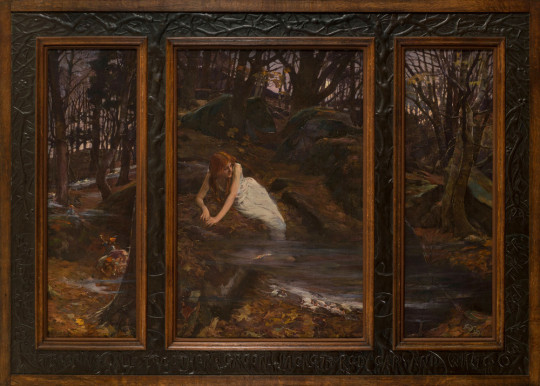
Elizabeth Adela Armstrong Forbes - Will-o’-the-Wisp (ca. 1900)
Elizabeth Adela Armstrong Forbes based her painting “Will-o’-the-Wisp” on the symbolic poem “The Fairies” by Irish poet William Allingham. She depicts the story of Bridget, who was stolen by “wee folk” and brought to the mountains for seven years. Upon returning to her village, Bridget discovers that all of her friends are gone.
Set in autumn with bare trees silhouetted against a moonlit sky, the triptych’s dark rocks, swirling mist, and eerie glow add to the mystical aura surrounding Bridget, the “stolen child…dead with sorrow…on a bed of flag leaves.” In the left panel, little forest denizens, who in Irish legends often entice young girls with sensory pleasures, troop through the forest.
“Will-o’-the-Wisp” displays the tenets of the Newlyn Art School in its meticulous portrayal of natural detail. Yet the work’s mythical world is characteristic of late Pre-Raphaelite paintings. So too is the elaborately hand-wrought oak frame, which incorporates sheets of copper embossed with intertwined tree branches. Lines from Allingham’s poem inscribed on the frame allude to the centuries-old philosophical dialogue between the relative artistic merits of painting versus poetry. (source)
81 notes
·
View notes
Text

Exceptional big oil on canvas Newlyn School landscape from the 19th century featuring a mother and kid looking out at distant ships off the coast. A Newlyn School scene painted on an exhibition scale, of excellent quality and condition. The vibrant use of light and lovely natural tones in the palette are typical of Forbes' paintings and others of his ilk.
NY Elizabeth
5 notes
·
View notes
Text
Henry Scott Tuke (1858-1929) was an English impressionist, and a prominent member of the Newlyn School. Tuke was renowned for his homoerotic paintings of nude men. He is also known for his maritime paintings of seascapes and ships. Tuke places an emphasis on light sources and warm colors, creating inviting and dynamic scenes.



Paintings featured
Green and Gold (1920)
Noonday Heat (1903)
Summer Dreams (1919)
#20th century#impressionism#henry scott tuke#homoerotism#maritime#painting#swimming#art history#english
18 notes
·
View notes
Text

Bouquet with Red Carnations, 1976
Rhoda Barbara Tribe (1913-2000, Australian-English)
Sculptor, painter, printmaker, Barbara studied at the Sydney Technical College from 1928 to 1933. In 1935 she was awarded a travelling scholarship which allowed her to travel to England, where she lived and worked for the rest of her life. Barbara's work was heavily influenced by her travel experiences. Between 1931 and 1934 sheoften exhibited with the Society of Artists before holding her first solo show in 1934. Also in the 1940s, she began exhibiting at the Royal Academy of Arts and the Royal Society of British Sculptors.
During the Second World War, Barbara worked for the Inspectorate of Ancient Monuments, recording vulnerable historic buildings. She took up a part time teaching post at the Penzance School of Art after the war, and continued to teach there for over 40 years, retiring in 1988. She was a member of Newlyn Society of Artists and St Ives Society of Artists.
https://www.artnet.com/artists/barbara-tribe/
#dianthus#carnation#daffodils#painting#still life#flowers#20th century art#20th century painting#woman artist#women in art#woman artwork#woman painter#Rhoda Barbara Tribe
2 notes
·
View notes
Photo
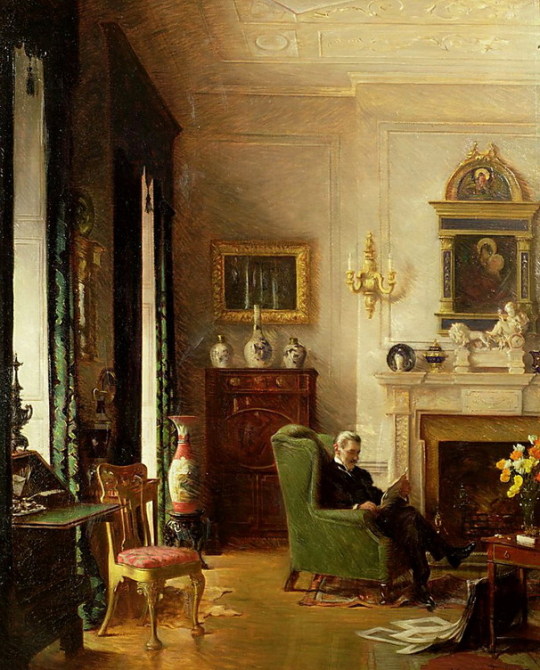
The Grey Drawing Room, (1917) by Albert Chevallier Tayler
Born in Leytonstone, Essex, in 1862 to a legal family, Albert Chevalier Taylor won a scholarship to the Slade School when he was 17. Having completed his education, he moved to Newlyn in 1884 and became one of the ""Newlyn Artists"", although he frequently also painted commissions elsewhere. In 1887, Taylor exhibited at the Royal Academy but he continued to work mainly in Newlyn. In 1891 he won a medal at the Paris Salon and from 1893 his subjects changed from fishermen to dinner parties and drawing rooms. In 1895 he moved to London and this is how he became a fashionable and successful artist with many commissions. In 1910 he became a full Member of the Royal Academy, exhibiting 49 paintings in total at the Academy, and he was also the Honorary Secretary of the Royal British Colonial Society of Artists. Albert Chevalier Taylor died in 1925. --Artbol
2 notes
·
View notes
Text
Artist Research
Rachel Duck House
Born in 1975, Rachel Duckhouse grew up in Nuneaton before studying at Leeds College of Art and Winchester School of Art, moving to Glasgow in 1998, where she now lives and works.
Her drawing practice explores structures, patterns and flows within landscapes and the dynamic relationships between things (particularly architecture, water, light and memory). Her research often combines observation, conversation, walking, archive research and sketchbook drawing, to explore the connection between inner and outer worlds through imagined geometries, patterns and places.
She’s undertaken research based residencies in Canada, Australia and the Outer Hebrides, and has exhibited her work in Europe, North America, New Zealand and Singapore. She’s worked on several public art commissions, including the entrance gates to the newly redeveloped Edinburgh Printmakers. Her drawings, etchings and screenprints have been acquired by collections including The British Museum, Great Ormond Street Hospital in London and Albert Einstein College of Medicine, New York.
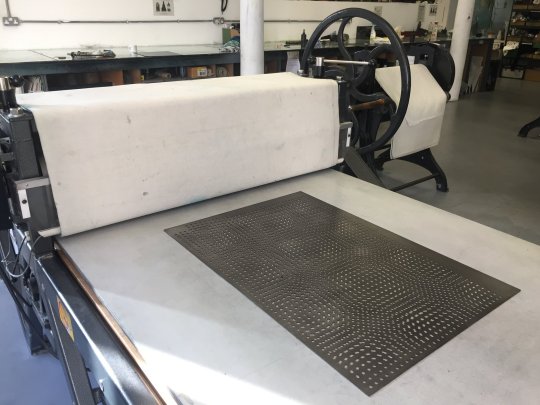
Water jet cut moiré pattern (originally screen printed) on steel for relief etching at Glasgow Print Studio.
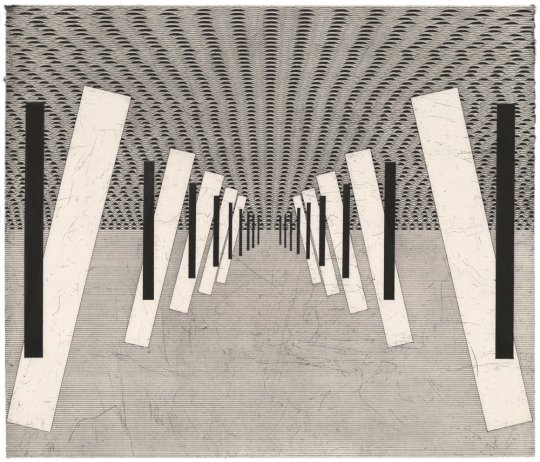
Over and Out (Newlyn)
Etching with pen and ink drawing

Green Fold
Screenprint
1 note
·
View note
Text
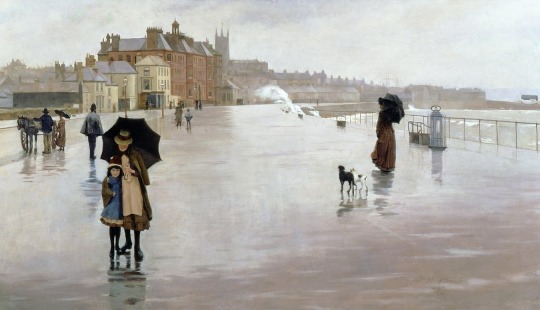
The Rain It Raineth Every Day.
Norman Garstin, 1889.
I was just about to get ready to go on my early morning walk when it started blummin' chuckin' it down. I couldn't find a painting on the Internet to adequately match my mood, so this one will have to do, due to the art history factor.
Acc. to Wikipedia:
Norman Garstin (1847-1926) was an Irish artist, teacher, art critic and journalist associated with the Newlyn School of painters. This was an art colony of artists based in or near Newlyn, a fishing village adjacent to Penzance, on the south coast of Cornwall, from the 1880s until the early twentieth century. The establishment of the Newlyn School was reminiscent of the Barbizon School in France, where artists fled Paris to paint in a more pure setting emphasising natural light. These schools, along with a related California movement, were also known as 'En plein air'. Plein-air painting is the act of painting outdoors.
The painting depicts the seafront between Newlyn and Penzance in windy and rainy weather. The use of negative space shows influence from French painter Edgar Degas, whom Garstin met when studying in Paris. Garstin sent the painting to the Royal Academy in 1889 but it was not selected for exhibition, possibly because the jury considered it was "too French" in style. The artist donated the work to Penzance Town Council, but it was not exhibited for some time after it was acquired, due to concerns that tourists would not wish to see Penzance in the rain.
I'm not massively interested in most art or history after the end of the 16th century, to be honest, but it has to be covered if I am to learn about the history of all civilisation from day dot. I tend to ignore Oriental art and history for the same reason - not my cup of camomile. Just personal preference, that's all. In a nutshell, just to be clear, my real interest lays in the art, history and religions of ancient and medieval Europe, Russia and the Near/Middle East. And cheese, which I am about to have for my breakfast on a slice of toast.
Thanks for reading and I hope you all have a nice day, even if it is blummin' raining and scuppering your plans like it is mine!
1 note
·
View note
Text
"It is time to go home" by Elizabeth Adela Forbes, 1889. Penlee House Gallery & Museum, Oil on canvas. H 106 x W 145 cm.
Through the window comes the afternoon sunlight, and the school door opens on to a pleasant yard with a little fence. Elizabeth was extremely fond of children and portrayed them in a number of her works." In 1900, she exhibited her work at the gallery of the Fine Art Society, under the title “Children and Child Lore” (Birch 72), and in 1904, according to Penlee House, she held an exhibition with the same title at the Leicester Gallery.
The sense of reality here is very strong, with typical interplay between teachers and children at the end of a school day. Some of the younger children are being shepherded out of the door, wearing their berets, and a little girl is standing on a chair to reach hers, on one of the pegs at the back of the room. A soberly dressed older girl, perhaps a monitor, is just packing her bag, while the little boy on the bench at the left is rubbing his eyes. Despite being indoors, the painting is filled with light and movement, and is a lovely example of the Newlyn School's productions.— Jacqueline Banerjee.
by Αφροδιτη Τσούκα
#edisonmariotti @edisonblog
.br
"É hora de ir para casa" por Elizabeth Adela Forbes, 1889. Penlee House Gallery & Museum, óleo sobre tela. A 106 x L 145 cm.
Pela janela entra o sol da tarde, e a porta da escola se abre para um agradável pátio com uma pequena cerca. Elizabeth gostava muito de crianças e as retratou em várias de suas obras." Em 1900, ela expôs seu trabalho na galeria da Fine Art Society, sob o título "Children and Child Lore" (Birch 72), e em 1904 , segundo Penlee House, ela realizou uma exposição com o mesmo título na Leicester Gallery.
O senso de realidade aqui é muito forte, com interação típica entre professores e crianças no final de um dia escolar. Algumas das crianças mais novas estão sendo conduzidas para fora da porta, usando suas boinas, e uma garotinha está de pé em uma cadeira para alcançar a dela, em uma das cavilhas no fundo da sala. Uma menina mais velha, vestida sóbria, talvez uma monitora, está apenas arrumando sua mala, enquanto o menino no banco da esquerda esfrega os olhos. Apesar de estar dentro de casa, a pintura é cheia de luz e movimento e é um belo exemplo das produções da Newlyn School. — Jacqueline Banerjee.

0 notes
Photo

@nikmosley I was born in Hong Kong and spent my childhood in the Far East living by the sea which has had a huge influence in my life and work. I moved to Paris in 1990 where I studied at Parsons School of Design. In 1997 I moved to Houston, Texas and studied Fine Art at The Glassell School of Art, the teaching wing of The Museum of Fine Art and exhibited extensively in solo and selected group exhibitions. I moved to Cornwall in 2014 and took on a studio at Krowji in Redruth. I studied at The Newlyn School of Art completing the fourteen week landscaping course and in 2016 I studied at Falmouth Art School’s Summer Intensives. In 2017 I became an Associate Member of Penwith Gallery in St. Ives and have exhibited in their selected group exhibitions. In 2020 I moved from my studio at Krowji to work from my new studio overlooking Falmouth harbour. My work is in private collections both nationally and internationally. https://theflyingfruitbowl.co.uk/2023/01/24/nicola-mosely/ Link in bio! 👀 #art #artist #creativeprocess #fineart #skypainting #painter #skyscape #landscapepainting #landscapeart #painters #fineartist #contemporaryart #artisttofollow #artpodcast #artwebsite #opencallforartists #painting #seapainting https://www.instagram.com/p/CnzCNkmIiu7/?igshid=NGJjMDIxMWI=
#art#artist#creativeprocess#fineart#skypainting#painter#skyscape#landscapepainting#landscapeart#painters#fineartist#contemporaryart#artisttofollow#artpodcast#artwebsite#opencallforartists#painting#seapainting
0 notes
Photo

Henry Scott Tuke - Gruppo di bagnanti - 1914
530 notes
·
View notes
Text

Mina Arndt - The Red Hat (ca. 1914)
After graduating from Wellington Technical School, Mina Arndt studied in London with Frank Brangwyn and at the artists’ colony in Newlyn, Cornwall, with Harold and Laura Knight. She also lived in Berlin, where she studied with progressive artists Lovis Corinth, her second cousin Julie Wolfthorn and printmaker Hermann Struck. Of these, it was the Germans’ sombre palette and techniques that most influenced Arndt.
Following the outbreak of war in 1914, and brief internment in Germany as a prohibited British alien, Arndt returned to Wellington, where she found an attic studio in Willis Street above Bartlett & Andrew’s photography shop. Early in 1915, in this ‘delightful room with many and quaint accessories’, she held a private exhibition of her overseas and recent paintings, etchings and drawings, probably including The red hat, now her best-known work.
The painting is typical of Arndt’s single-figure compositions that fill the frame. The model, Wellingtonian Daisy Hay, wears a shapely buttoned tunic and is silhouetted by the soft light behind her, which also highlights the thickly painted green wall. Her face is cursorily built up with rapidly hatched brushstrokes, leaving her expression inscrutable, as though she has drifted off while posing. Once it becomes clear that this is not a portrait intended to reveal Daisy’s personality, the eye moves upwards to contemplate her crowning glory — the hat. Its oval form is swathed in a scarf, expressively rendered in crosshatched slashes of deep red paint. Its gorgeous painterliness and hue are enhanced and thrown into focus by the simple flat background of harmonious brown and green. An Auckland Star critic, perhaps failing to appreciate Arndt’s subtlety in using shape and colour, and accustomed to bright post-impressionist palettes of artists such as Edward Friström, found her art ‘a little wantingin colour and lightness’.
In 1917 Arndt married Leo Manoy and settled in Motueka, where she worked and taught from a home studio. She produced memorable domestic images of mothers and children, and also of Māori women washing clothes, which she exhibited throughout New Zealand and Australia until her early death aged forty-one. (source)
67 notes
·
View notes